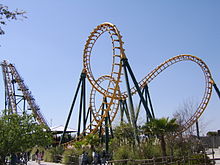
A roller coaster is a type of amusement ride employing a form of elevated railroad track that carries passengers on a train through tight turns, steep slopes, and other elements usually designed to produce a thrilling experience. Trains consist of open cars connected in a single line, and the rides are often found in theme parks around the world. Roller coasters first appeared in the 17th century, and LaMarcus Adna Thompson obtained one of the first known patents for a roller coaster design in 1885, based on the Switchback Railway which opened a year earlier at Coney Island.

Vekoma Rides Manufacturing is an amusement ride manufacturer. Vekoma is a syllabic abbreviation of Veld Koning Machinefabriek which was established in 1926 by Hendrik op het Veld.

A roller coaster inversion is a roller coaster element in which the track turns riders upside-down and then returns them to an upright position. Early forms of inversions were circular in nature and date back to 1848 on the Centrifugal railway in Paris. These vertical loops produced massive g-force that was often dangerous to riders. As a result, the element eventually became non-existent with the last rides to feature the looping inversions being dismantled during the Great Depression. In 1975, designers from Arrow Development created the corkscrew, reviving interest in the inversion during the modern age of steel roller coasters. Elements have since evolved from simple corkscrews and vertical loops to more complex inversions such as Immelmann loops and cobra rolls. The Smiler at Alton Towers holds the world record for the number of inversions on a roller coaster with 14.

An inverted roller coaster is a type of steel roller coaster in which the train runs under the track with the seats directly attached to the wheel carriage. Riders are seated in open cars, letting their feet swing freely. The inverted coaster was pioneered by Swiss roller coaster manufacturer Bolliger & Mabillard in the early 1990s with the development of Batman: The Ride, which opened at Six Flags Great America on May 9, 1992.

A stand-up roller coaster is a roller coaster where passengers aboard a train stand throughout the course of the ride. The first manufacturer to employ the format was TOGO, a Japanese company that converted two traditional roller coasters in 1982 to stand-up configurations. Arrow Dynamics followed suit in the United States the following year with their own conversion. The first roller coaster designed from the ground up as a stand-up coaster was King Cobra, built by TOGO, which opened at Kings Island in 1984. Intamin and Bolliger & Mabillard (B&M) have also designed stand-up models beginning in the 1990s, with the latest opening in 2023 as Pipeline: The Surf Coaster in SeaWorld Orlando, which was the first stand up roller coaster built since 1999's Georgia Scorcher at Six Flags Over Georgia.

The launched roller coaster is a type of roller coaster that initiates a ride with high amounts of acceleration via one or a series of linear induction motors (LIM), linear synchronous motors (LSM), catapults, tires, chains, or other mechanisms employing hydraulic or pneumatic power, along a launch track. This mode of acceleration powers many of the fastest roller coasters in the world.

A suspended roller coaster is a type of steel roller coaster in which the car hangs from the bottom of the rolling stock by a pivoting fulcrum or hinge assembly. This allows the car and riders to swing side to side as the train races along the track. Due to the swing designs, these roller coasters cannot invert riders.
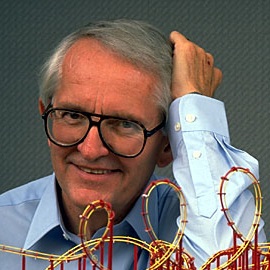
Ronald Valentine Toomer was an American roller coaster designer credited for designing 93 roller coasters around the world. He graduated from the University of Nevada, Reno in 1961 with a degree in mechanical engineering and was a part of the design team responsible for the Apollo spacecraft heat shield.

Boomerang is a model of roller coaster manufactured and designed by Vekoma, a Dutch manufacturer. The roller coaster model name is from the hunting implement based on the traditions of the Indigenous Australians. As of January 2023, there are 55 Boomerangs operating around the world.

A Giant Inverted Boomerang is a type of steel shuttle roller coaster manufactured by the Dutch firm Vekoma. The ride is a larger, inverted version of Vekoma's popular Boomerang sit down roller coasters. As of January 2025, three installations of the model are operating with another one being SBNO.

Boomerang: Coast to Coaster is a steel shuttle roller coaster currently at several parks in North America. The roller coaster was designed and manufactured by Vekoma, and is considered as one of its boomerang models. At the time of installation in the late 1990s, the coaster was built at parks operated by Six Flags. All five coasters were originally known as Boomerang: Coast to Coaster, although three have since been renamed.

Flashback is a steel roller coaster of shuttle design currently operating at Six Flags New England. The ride has one train with a capacity of twenty-eight riders, two across in each row. When the coaster starts, the train is pulled backwards up the lift hill, then dropped through the loading gate into a cobra roll and then one loop. At the end of this cycle, the train is pulled up the lift hill at the end of the track. It is then released, allowing the train to traverse the track in the opposite direction. The ride is an off-the-shelf Vekoma Boomerang design common in many amusement parks.
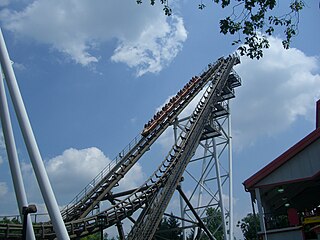
Jolly Rancher Remix is a steel shuttle roller coaster located at Hersheypark in Hershey, Pennsylvania, United States. A Boomerang model manufactured by Vekoma and designed by Peter Clerx, the roller coaster originally opened as the Sidewinder on May 11, 1991. The roller coaster debuted in the Pioneer Frontier section of the park and cost $4.2 million. The Sidewinder was the first roller coaster installed in the park in 14 years since the SooperDooperLooper in 1977 and the fourth roller coaster in operation to be built. The roller coaster has a maximum height of 116.5 ft (35.5 m), with a maximum speed of 47 mph (76 km/h), and a track length of 935 ft (285 m).
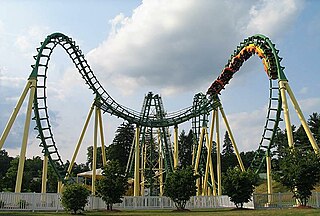
Zoomerang is a steel shuttle roller coaster located at Lake Compounce in Bristol, Connecticut. A Boomerang model manufactured by Vekoma, it contains a cobra roll and a vertical loop. Zoomerang was the first boomerang coaster to receive a Vekoma-designed train. Earlier models used trains designed by Arrow Dynamics. In September 2007, due to paint deterioration, the ride was repainted with a new color scheme featuring purple tracks and teal supports.

Shuttle Loop is a type of steel launched shuttle roller coaster designed by Reinhold Spieldiener of Intamin and manufactured by Anton Schwarzkopf. A total of 12 installations were produced between 1977 and 1982. These 12 installations have been located in a total of 22 different amusement parks.

The Thunderbolt Express was a looping shuttle roller coaster located at Camden Park. Originally named Screamin' Demon when it operated at Kings Island from 1977 to 1987, the roller coaster was built and designed by Arrow Dynamics. It was sold to Camden Park following the 1987 season, and reopened at its new location in 1988. Following an electrical issue in 1999, the ride was closed indefinitely for a period of time. An announcement surfaced that the ride would reopen in 2002, but the roller coaster was dismantled following the 2004 season and replaced by a miniature golf course.
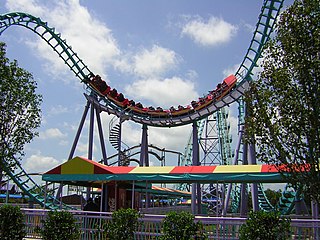
Zydeco Scream was a steel roller coaster located at the now defunct Six Flags New Orleans in New Orleans, Louisiana. Manufactured by Vekoma, the Boomerang coaster model opened to the public on June 10, 2000. Following the devastation to the amusement park in August 2005 by Hurricane Katrina, the roller coaster ceased operation following the park's closure but remained standing until its demolition in 2024. Prior to Six Flags New Orleans, the ride operated at Parc de Montjuic in Barcelona, Spain from 1990 to 1998.

Batgirl is a shuttle roller coaster operating at Six Flags México since 1988. Originally built by Vekoma in 1984, it was the first of the company's Boomerang model.

Goliath was a steel shuttle roller coaster located at Six Flags New England in Agawam, Massachusetts. Manufactured by Vekoma, the ride originally opened as Déjà Vu at Six Flags Magic Mountain in 2001. The ride was a larger, inverted version of Vekoma's popular Boomerang sit-down roller coasters. In 2021, the park removed the ride from its map indicating it would not reopen for the remainder of the season. In late 2021, demolition of the coaster began.
